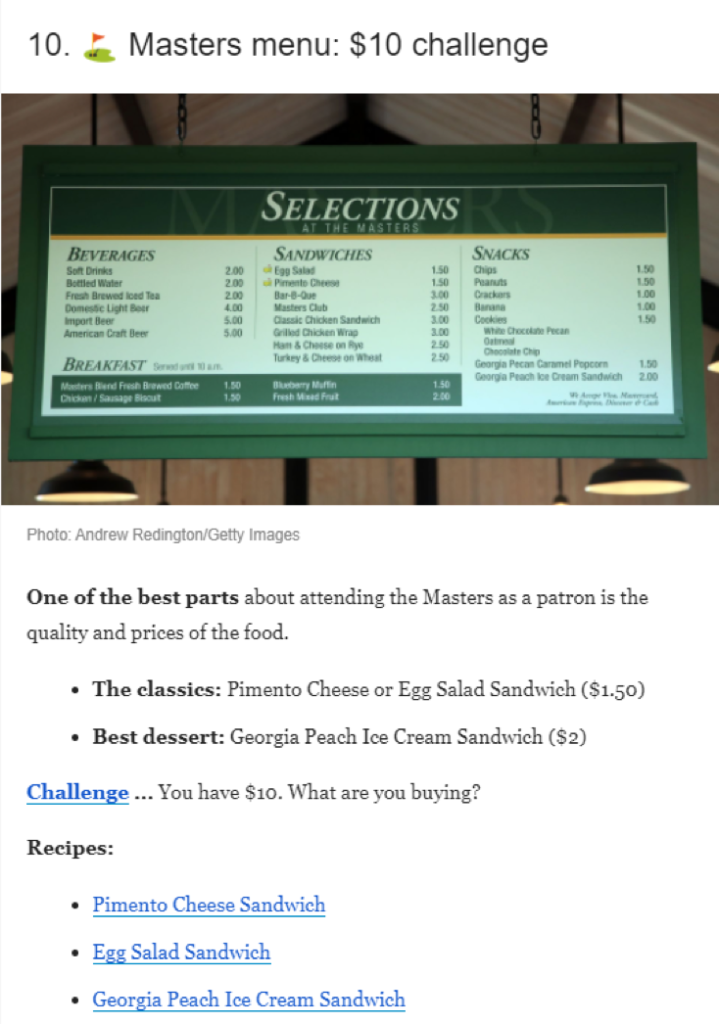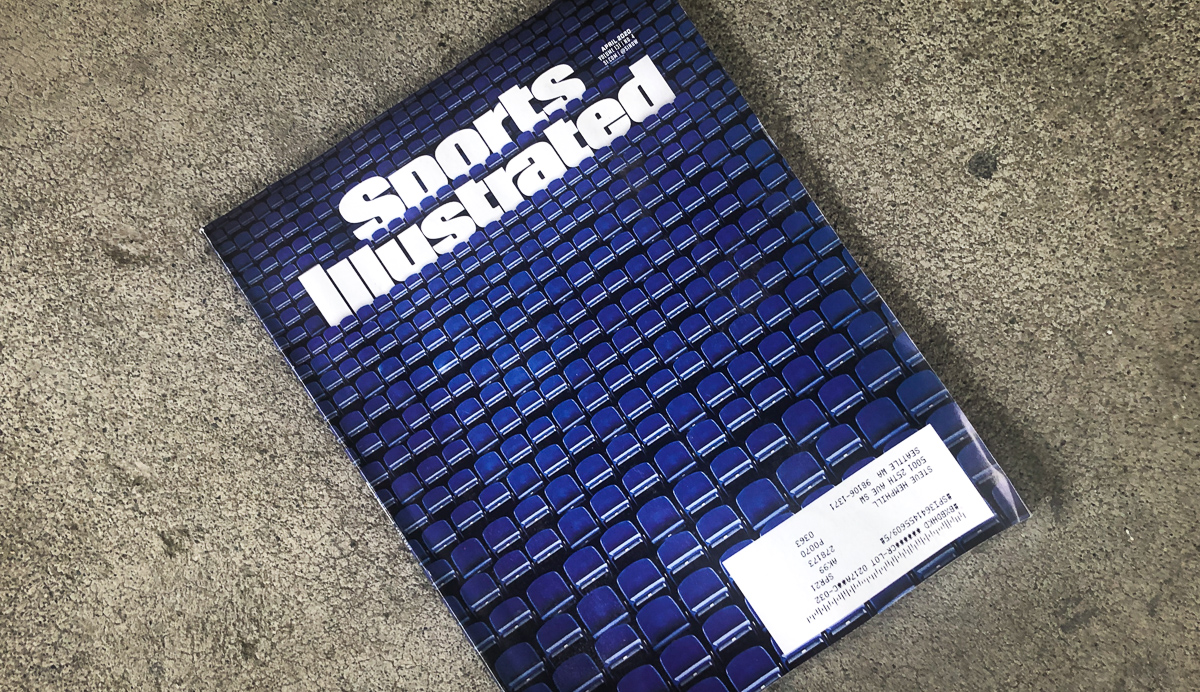Picture yourself in New York’s Metropolitan Museum of Art when someone presents you with a challenge: Select the top 10 works in the museum’s 11,000 piece collection in less than an hour, prioritize them in terms of their importance to the art world, and write a recap that is no more than 1500 words highlighting key aspects of each. And, just for kicks, produce custom images and add statistics that will wow an eager group of a cool half-million art enthusiasts.
The analogy may be a bit dramatic, but that is, in a sense, what the team at Axios Sports does five days a week, 52 weeks a year. Kendall Baker, Axios’ sports editor, and Axios sports writer Jeff Tracy, spend their work days scouring the entire world of sports—everything from the NBA to cricket to cornhole—to identify the stories they feel their 500,000 subscribers want to know about that day. In less than 24 hours, they brainstorm, write, curate, edit, and publish a daily Monday-through-Friday newsletter that is redefining how sports writing is performed and the way fans consume information.
“There were a million [newsletters] for politics, a million for tech and finance, but nobody was really doing sports,” Baker says. “What I thought was [ESPN’s] Sportscenter in an email.”
Axios, a 5-year-old media company which produces various newsletters, web content and even a show on HBO, uses what it calls a “smart brevity” to provide “smarter, more efficient coverage of the topics shaping the fast-changing world.” Baker and Tracy not only have to choose what is important, they have to ensure that the newsletter is as efficient as possible since word count and reading time sits at the top of every email.
“If there is even a single word that doesn’t add value I take it out,” says Baker.
The process begins around 10:30 a.m. EST on Sunday and runs through 7:30 a.m. on Friday when the final email of the week is distributed. While there is downtime throughout the week (and the goal of having Tracy’s day ending by 7:30 p.m. and Baker in bed by 10), this is not a nine-to-five endeavor; in fact, it never truly stops. What has been chosen to be in the newsletter could easily be out depending on what happens while Tracy in Brooklyn and Baker in Washington, D.C. are asleep. LeBron twisted an ankle? Someone in San Francisco pitched a perfect game? There was a stadium collapse at an event in India? The body’s need for sleep may be the only nature-imposed guardrail for these two sports enthusiasts who, if left to their own devices, would probably not invest in mattresses.
“I think when you are running something like a newsletter and you are doing a lot of work and in the weeds all day long, it’s really nice to have a coworker who you get along with and who is equally passionate about sports,” Baker says. “I don’t think I could do this with somebody who didn’t love sports like I do.”
The high-level workflow utilizes a combination of phone discussions, collaboration via a digital tool called Notion, and constant communication via Slack. While the topics vary day-to-day, Baker and Tracy have developed a cadence that brings a level of structure and organization to what they do. Starting with a rundown meeting, the two discuss current happenings in the world of sports, make a first pass at what will be included, and map out a daily strategy. They work off a template in Notion, sticking to a top 10 format that starts with “One Big Thing,” includes a “Lightning Round” segment, and ends with “On This Date,” “Trivia,” and “Top Plays” or a fun item. Throughout it all, the decision of what constitutes a topic’s worthiness is nuanced.

“I always take into account the flow of the newsletter itself,” Baker says. “I don’t want the top three stories to all be long and in-depth, or even the same sport. I try and never have two of the same sports in a row unless it’s March Madness, or something like that, where it’s unavoidable. It’s really more art than science. There’s not really a method to it.”
For example, on Wednesday, April 6, the day before the start of the Masters golf tournament, Baker and Tracy spent about an hour discussing a wide spectrum of topics that ranged from Augusta National Golf Club’s greens (“They say it could be firmer than it has been in 15 years.”) to the NCAA men’s hockey Frozen Four (“It’s interesting that three of the teams are from Minnesota; maybe we could have a map?”) to the NBA’s Phoenix Suns (“Take a look at these stats, maybe that’s our story.”), culminating with a six-minute conversation about the cost of the concessions at the Masters and how to incorporate that subject into the tenth slot, a section devoted to the unique (“Look how low the prices of hotdogs are. Is there a recipe for pimento cheese sandwiches? If you had ten bucks to spend at the Masters, what would you eat?”).
While those items were in the next day’s edition, a possible article on shortstops initially slated for April 7 was removed—at least for this round. Baker and Tracy will keep a draft of the story and enter notes so that when the timing is right, the story is available and the process stays speedy.

Though the newsletter is designed to provide readers with a quick scroll of key stories on a particular day, the short, bulleted lists often link to deeper articles, some written by Baker, Tracy, others at Axios or, more likely, to content produced by other sites such as The Athletic or ESPN.com. After some experimentation and research, Baker placed a bet that sports fans, especially those with busy lifestyles and who are bombarded with information, wanted something that would allow them to quickly get up to speed on what is happening at a high level, and then go deeper on stories that were important to them. He also believes that while local sports coverage is important, there is a change in what the next generation of fans want in terms of content.
“My theory was that sports is trending more and more national,” Baker says. “And while there is still room for you to go deeper into team-by-team coverage like The Athletic does, you have to hire hundreds of people to do that. [Ours] is a totally different model, but there’s room for both.”
There may not be a Pulitzer Prize for bulleted sports content, but Baker and Tracy are leading a major transformation in sports journalism. In only three years, the number of Axios Sports subscribers has grown from 11,000 to 500,000 and the trajectory shows no signs of slowing. The pair have strong relationships with a variety of media outlets that often ask to link from the Axios newsletter to their own content.
It helps that Axios is thriving, profitable and expanding—things that will only help to facilitate even greater traction and readership. Just like the pace Baker and Tracy keep all week, the speed at which the newsletter continues to grow and exert influence is constantly accelerating.
“I set out to create the sports page for the modern fan, and I think we’ve done that,” Baker says. “Now it’s just a matter of reaching more people, expanding our coverage and continuing to grow.”



